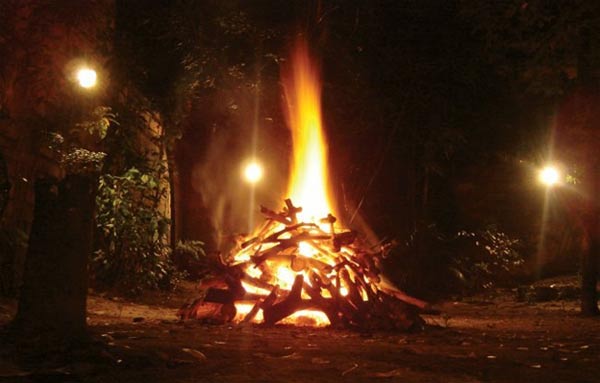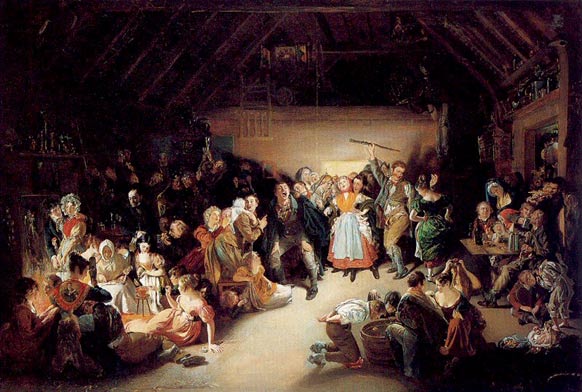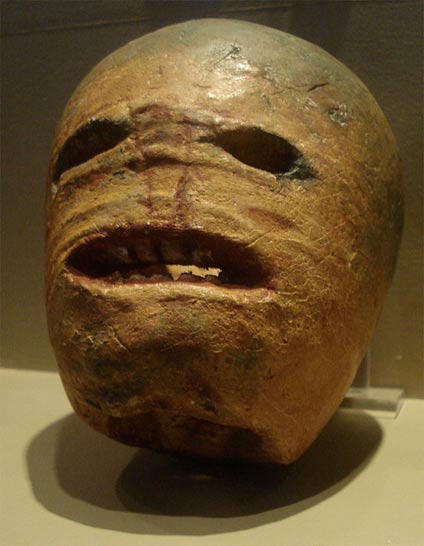30 OCTOBER, 2014 - 21:46 LIZLEAFLOOR
Crossing the Veil: The Pre-Christian Origins of Halloween and Samhain
Halloween, or the ancient Samhain, is considered the time of year when the veil between our world and the spirit world is at its thinnest. As darkness falls and families light their pumpkin Jack-o'-lanterns, they are, perhaps unknowingly, repeating the ancient traditions of honoring the dead and marking the beginning of the ‘dark half’ of the year.
Halloween is an annual celebration held largely in the western world on October 31st. Starting in the evening, children, and sometimes adults, dress in masks and costumes, traditionally as ghostly figures, witches, or the undead – vampires, zombies, skeletons. They go knocking door-to-door, requesting treats, or else threatening a mischievous trick upon the household. Typical activities of the modern observance can include costume parties, pumpkin carving, trick-or-treating, lighting bonfires, playing pranks and more.
Hallowe’en, a shortened form of "All Hallows' Evening" is the echo of Celtic harvest festivals of pre-Christian Europe. Observed now in several countries around the world, it is the evening before ‘All Hallows Day’, when saints (hallows) and martyrs are remembered by people of many Christian denominations. This ritual, however, coincides with (and some scholars suggest co-opted) the ancient observance of Samhain.
Samhain (pronounced sah-van or sow-in) is the traditional Gaelic festival marking the change of seasons and the approach of winter. Wikipedia describes this pre-Christian custom: “Many important events in Irish mythology happen or begin on Samhain. It was the time when cattle were brought back down from the summer pastures and when livestock were slaughtered for the winter. As at Beltane, special bonfires were lit. These were deemed to have protective and cleansing powers and there were rituals involving them. Samhain (like Beltane) was seen as a liminal time, when the spirits or fairies (the Aos Sí) could more easily come into our world.” Fires, and later candles, were lit to mimic the sun and hold back the dark of the oncoming winter.

A bonfire, ancient tradition at Samhain (Source)
Dead and departed relatives played a central role in the tradition, as the connection between the living and dead was believed stronger at Samhain, and there was a chance to communicate. Souls of the deceased were thought to return to their homes. Feasts were held and places were set at tables as a way to welcome them home. Food and drink was offered to the unpredictable spirits and fairies to ensure continued health and good fortune.
The idea that souls return home on a certain day of the year is repeated across many cultures around the world. Día de Muertos, or the Day of the Dead is a similar holiday in Mexico celebrating and honoring family members who have died. Similarly, this falls on October 31st, and November 1st and 2nd.
Samhain saw a metamorphosis due to the early church. In The History of Halloween or Samhain, Jack Santino writes, “As a result of their efforts to wipe out ‘pagan’ holidays, such as Samhain, the Christians succeeded in effecting major transformations in it. In 601 A.D. Pope Gregory the First issued a now famous edict to his missionaries concerning the native beliefs and customs of the peoples he hoped to convert. Rather than try to obliterate native peoples' customs and beliefs, the pope instructed his missionaries to use them: if a group of people worshipped a tree, rather than cut it down, he advised them to consecrate it to Christ and allow its continued worship.”
In the 12th century, holy days of obligation across Europe involved town criers dressed all in black, ringing mournful bells and calling on Christians to remember the poor souls of the dead. Special ‘soul cakes’ would be baked and shared. This custom of “souling” was shared in England, Germany, Belgium, Austria and Italy, and is thought to be the early precursor of trick-or-treating.
Eventually, mumming and guising (going door-to-door in disguise and performing in exchange for food) was taken up in a depiction of these ancient customs. Pranks were a way of confounding evil spirits. Pranks at Samhain date as far back as 1736 in Scotland and Ireland, and this led to Samhain being dubbed “Mischief Night”.

Painting of a Halloween party in Ireland, 1832. By Daniel Maclise. (Wikipedia)
Many of the modern practices for Halloween date to 19th century England and North America. Fortune telling and divination played a part in celebrations. Games were played intending to divine one’s future. Nuts and fruit featured in the eating and drinking games, and soul cakes were prepared.
For Halloween, pumpkins are hollowed out, and spooky faces are carved into them, creating Jack-o'-lanterns. Candles are then lit inside the pumpkins, creating eerie lanterns, and serving as signals that a household observes Halloween. Pumpkins are frequently used today as they’re easier to carve and a symbol of harvest, but the original lanterns in Ireland and Scotland were carved from turnips. These turnip lanterns were used to frighten off evil spirits by guisers, and were a motif of the Irish Christian folk tale of Jack, a wandering soul, who was denied entry into both heaven and hell.

A traditional Irish turnip Jack-o'-lantern from the early 20th century. (Creative Commons)
Observing Halloween is not without controversy. Some religions discourage participation, suggesting that it trivializes Samhain, it has satanic associations, or it is inappropriate tribute to paganism or the occult. However, the modern practices heavily influenced by commercialization and popular culture differ appreciably from the ancient traditions of Samhain and All Hallows’ Eve. Still, the connection exists and the history is clear - when you light a Jack-o'-lantern and brighten the darkening season, you’re carrying on an age-old tradition that bridges cultures around the world and reaffirms our connection to our departed loved ones.
Featured image: Symbols of Samhain and Halloween – fire, the dead, lanterns, harvest (Image Source)
By Liz Leafloor
References
Halloween - Wikipedia
Samhain - Wikipedia
The History of Halloween or Samhain - About

No comments:
Post a Comment